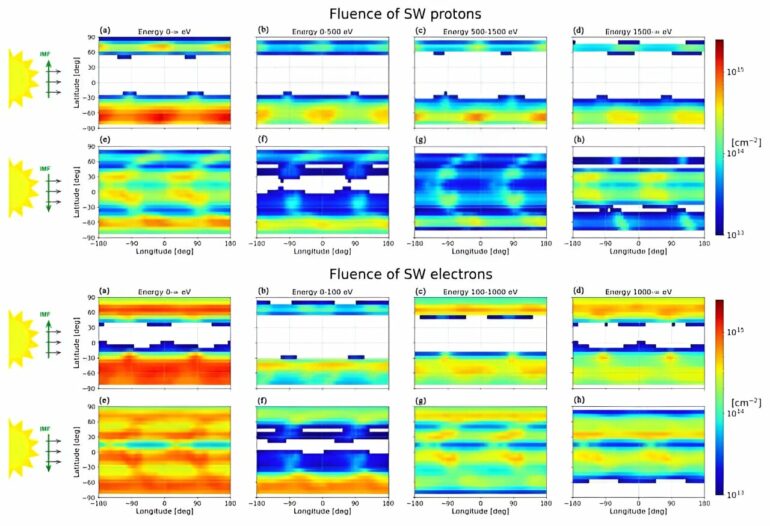A new study maps the infall of protons and electrons from the solar wind to geographical location on the surface of Mercury, giving scientists new insight into how interactions with the sun alters the surface and produces Mercury’s very thin atmosphere.
“Studies that have examined the infall of protons and electrons from the solar wind typically map the infall to the surface in terms of time-of-day (dawn, noon, dusk) and not in terms of geographic location (longitude),” said Planetary Science Institute Senior Scientist Elizabeth A. Jensen, a co-author on the paper “Maps of Solar Wind Plasma Precipitation onto Mercury’s Surface: A Geographical Perspective” that appears in The Planetary Science Journal.
“This is one of the first papers to take a close look at how the surface of Mercury is impacted by the solar wind charged particles as a function of location on the surface and the energy of the infalling protons and electrons. This is important for scientists who examine the properties of the surface.”
“We are trying to understand where the protons and electrons hit the surface and build up physical effects on the regolith and atmosphere in the process. In previous maps, they show how many protons and electrons hit the surface at a certain time of day. But, for example, dawn occurs at all places across the surface. So you might think that the amount of protons and electrons hitting the surface should be the same all over.”
“However, Mercury has this really strange orbit and rotation property. For every two times Mercury orbits the sun, it turns on its axis three times. We call this a 3-to-2 spin-orbit resonance. So the Mercury day lasts a little less than a Mercury year. Not only that, but Mercury also spends more time with some longitudes facing the sun than others. Also, the orbit is elliptical, not circular, so the amount of material from the solar wind is different on average depending on where in the orbit it is,” Jensen said.
“Mapping the infall of these particles, not only needs to account for the spin-orbit resonance and the location within the elliptical orbit, but also the interactions of the solar wind with Mercury’s magnetic field,” Jensen said. “It’s a complicated system with many moving parts. In order to convert the time-of-day maps to geographic maps the modeling results describing the infall of protons and electrons from the solar wind through Mercury’s magnetic field were integrated over the time span equivalent to a full Mercury day, lasting roughly two full orbits of Mercury around the sun.”
PSI’s Deborah Domingue is also a co-author on the paper led by Federico Lavorenti of the Laboratoire Lagrange of the Observatoire de la Côte d’Azur at the Université Côte d’Azur in Nice, France, and the Dipartimento di Fisica “E. Fermi” at the Università di Pisa in Pisa, Italy. Lavorenti is an expert in modeling the interactions of the solar wind with magnetic fields and Domingue has studied interactions between planetary surfaces and the solar wind.
“Does this mean that solar winds alter the regolith on the surface of Mercury? Yes, the solar wind does alter the surface. It’s the interaction of the solar wind that helps generate the exosphere, which is a very thin atmosphere, and space weathers the minerals that comprise the surface,” Domingue said. “This paper does not focus on the generation of the exosphere or the space weathering of the surface, but provides the information of the variation in the radiation flux across the surface that is needed for those who do study these phenomena.”
In contrast to Mercury, Earth’s atmosphere is too thick for solar wind protons and ions to reach the surface in general. Additionally, the Earth’s magnetic field only leaves the polar regions open to the infall. This produces the aurora borealis near the north pole, the aurora australis near the south, as well as the polar rain and other effects.
More information:
Federico Lavorenti et al, Maps of Solar Wind Plasma Precipitation onto Mercury’s Surface: A Geographical Perspective, The Planetary Science Journal (2023). DOI: 10.3847/PSJ/acef15
Data archive to study: zenodo.org/record/8311627
Provided by
Planetary Science Institute
Citation:
Mapping the sun’s interaction with Mercury’s surface (2023, September 13)
